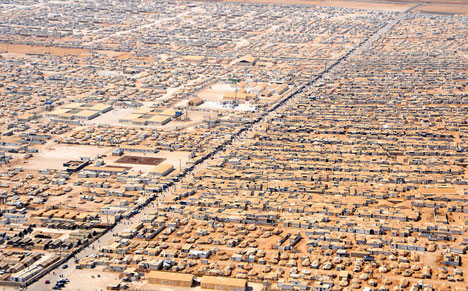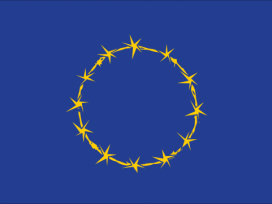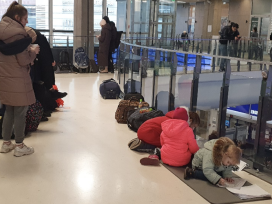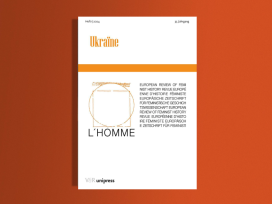I
On 16 February 2014, The New York Times Magazine ran an article entitled Container City.” “Container City” refers to the Kilis camp in southern Turkey housing 14, 000 refugees from Syria. Protected by high gates and surrounded by barbed wire, Kilis from the outside shares features with many refugee camps all over the world that make them indistinguishable from prisons or criminal detention centres. Kilis houses its population in 2,053 identical containers, spread in neat rows. The pictures that accompany the article remind one of shipping containers at a harbour. Each container is a 23-by-10-foot trailer with three rooms; and a colour TV with close to 1000 channels, probably picking up programs from all the surrounding countries of the Mediterranean.

Aerial view of Zaatri refugee camp, Jordan, 18 July 2013. Photo: US Department of State. Source: Wikimedia
Yet there are some unique features of Kilis besides the cleanliness of its streets and the organization of proper electricity, water and sewage services which led one Syrian resident to refer to it as “a five star hotel.” There are schools in the camp, sex-segregated according to the wishes of the Syrians; three grocery stores where refugees can buy supplies with a credit card; a beauty salon and a barbershop where refugees get free haircuts and other services; art workshops and gymnastics classes. But despite all this: “Nobody likes living there […I]t is hard for us,” said Basheer Alito, the section leader who was so effusive in his praise for the camps and the Turks. “Inside, we’re unhappy. In my heart, it’s temporary, not permanent.”
The Kilis refugee camp is by now one of hundreds in dozens of countries around the world. A report by the United Nations High Commissioner of Refugees notes that by mid-2014, the number of refugees worldwide stood at the highest level on record, namely at around 45 million; and with no end in sight to conflicts in places such as Syria, Central African Republic and the Democratic Republic of the Congo this number will only continue to increase. As the number of refugees has grown worldwide, not only has the number of camps grown as well, but the camps have ceased to be places where one held people temporarily; rather, they have become semi-permanent. The largest refugee camp in the world, Kenya’s Dadaab, is 20 years old and houses 420,000 refugees. The Palestinian refugee camps in Southern Lebanon are in many cases nearly 70 to 50 years old, depending on whether the refugee population was created in 1948 or 1968. The refugees who live in these camps, and who in some cases have spent their entire lives there, become PRSs, that is, those in a “protracted refugee situation.”
Refugees, asylees, IDPs (internally displaced persons), PRSs, stateless persons: these are new categories of human beings created by an international state-system in turmoil, human beings who are subject to a special kind of precarious existence. Although they share with other “suffering strangers” the status of victimhood and become the objects of our compassion – or as the UNHCR report puts it, become “persons of concern” – their plight reveals the most fateful disjunction between so-called “human rights” – or “the rights of man”, in the older locution – and “the rights of the citizen”; between the universal claims to human dignity and the specificities of indignity suffered by those who possess only human rights. From Hannah Arendt’s famous discussion of the “right to have rights” in The Origins of Totalitarianism to Giorgio Agamben’s homo sacer to Judith Butler’s “precarious lives” and Jacques Rancière’s call to “the enactment of rights”, the asylum seeker, the stateless and the refugee have become metaphors as well as symptoms of a much deeper malaise in the politics of modernity.
Yet as political fatigue about internationalism has gripped the United States in the wake of the interventions in Afghanistan and Iraq, and president Obama’s politics of caution in Syria has created further moral quagmires, we have moved from “the right to have rights” to the “critique of humanitarian reason.” Didier Fassin, who for many years worked with Médecins Sans Frontières in a high capacity, and to whom we owe this term, defines it as follows: “Humanitarian reason governs precarious lives: the lives of the unemployed and the asylum seeker, the lives of sick immigrants and people with AIDS, the lives of disaster victims and victims of conflict – threatened and forgotten lives that humanitarian government brings into existence by protecting and revealing them.” Subtitled “A Moral History of the Present”, Fassin’s felicitous book signals a more widespread retreat from the politics of human rights which began shortly after the US invasion of Afghanistan and Iraq to a denunciation of human rights, in the words of the Columbia historian, Samuel Moyn, as an “antipolitics” that survived as a “moral utopia when political utopias died.” Some sought to achieve, writes Moyn, in his provocatively titled book, The Last Utopia: Human Rights of History, “through a moral critique of politics the sense of pure cause that had once been sought in politics itself”; further, human rights substituted a “plausible morality for failed politics.” Fassin himself is more careful and balanced than Moyn in his critique of human rights discourse and practice, but nonetheless both works and the success they have enjoyed document an important moment at least in the zeitgeschichte of the United State’s recent political culture.
This intellectual and political disillusionment was heralded even before Moyn’s 2010 book. In a trenchant article of 2004 entitled “Who is the subject of the rights of man?”, after the US wars in Afghanistan and Iraq were at their height, Jacques Rancière begins by noting how the Rights of Man, or in more contemporary language, Human Rights, which were rejuvenated by the dissident movements of Eastern Europe and the Soviet Union in the 1970s and ’80s, became transformed in the first decade of the twenty-first century into “the rights of the rightless, of the populations hunted out of their homes and land and threatened by ethnic slaughter. They appeared more and more as the rights of the victims, the rights of those who were unable to enact any rights or even any claims in their name, so that eventually their rights had to be upheld by others, at the cost of shattering the edifice of International Rights, in the name of a new right to ‘humanitarian interference’ – which ultimately boiled down to the right to invasion.” “Human rights, the rights of the rightless” became for Ranciere the ideological scaffolding for “humanitarian reason” at best and for “humanitarian intervention” at worst.
This prevalent mood of disillusionment and cynicism among many concerning human rights and humanitarian politics is understandable; but it is not defensible. Developments in international law since 1948 have tried to give new legal meaning to “human dignity” and “human rights”. Admittedly, these developments have in turn generated the paradoxes of “humanitarian reason”, but the way to work through these paradoxes is not to turn against the jus gentium, the law of nations, of our world; instead, we need a new conceptualization of the relationship between international law and emancipatory politics; a new way of understanding how to negotiate the “facticity” and the “validity” of the law, including international human rights and humanitarian law, such as to create new vistas for the political.
II
In a well-known passage of The Origins of Totalitarianism, Hannah Arendt wrote: “We become aware of the existence of a right to have rights (and that means to live in a framework where one is judged by one’s actions and opinions) and a right to belong to some kind of organized community, only when millions of people emerge who had lost and could not regain these rights because of the new global political situation […] The right that corresponds to this loss and that was never even mentioned among the human rights cannot be expressed in the categories of the eighteenth-century because they presume that rights spring immediately from the ‘nature’ of man […] the right to have rights, or the right of every individual to belong to humanity, should be guaranteed by humanity itself. It is by no means certain whether this is possible.“ The “right to have rights” has become the well-known phrase through which to capture the plight of the stateless, the refugee, the asylee and displaced persons – that is, the plight of those who have been cast out of the framework “where one is judged by one’s actions and opinions.”
Throughout this discussion, Arendt polemicizes against the grounding of human rights upon any conception of human nature or history. For her, conceptions of human nature commit the mistake of treating humans as mere substance, as if they were things in nature. But following Augustine and Heidegger, for her humans are the ones for whom the question of being has become a question. She quotes Augustine: “Quid ergo sum, Deus meus? Quae natura sum? (“What then am I, my God? What is my nature?”) The answer is simply,”quaestio mihi factus sum”, “I have become a question for myself.” And this capacity for self-questioning is also the source of one’s freedom. Although human freedom is not limitless and is subject to the facticity of the “human condition” –namely worldliness, plurality, natality, labour, work, and action – it is with reference to this condition alone and not in the light of a fixed “human nature” that we must try to justify the right to have rights.
Arendt’s rejection of any justificatory role that the concept of history may play is complex. We know that from the late 1950s she was engaged in a conversation with Karl Marx, whom she accuses of having brought the tradition of western political thought to an end by substituting a philosophy of history for a political philosophy proper. Arendt’s reading of Marx is often dismissive and I am not concerned to evaluate it here. But for her, as for Walter Benjamin, whose “Thesis on the Philosophy of History” she brought over to the United States with her in a suitcase after his suicide in Port-Bou and from whom she learned a great deal, any deterministic account of history, either privileging a mechanism of social forces that act as the engines of change, or any teleological account of history which attributes to it an end-goal, a telos, is intellectually shallow. Even more, it is morally reprehensible because it makes humans into “instruments of a world-spirit” and robs them of oppositional agency. One has to act “against the grain of history”, to use a Benjaminian locution.
These philosophical puzzles of the justification of human rights continue in our own days as well. Thus, the first article of the Universal Declaration of Human Rights (UDHR) reads: “All human beings are born free and equal in dignity and rights. They are endowed with reason and conscience and should act towards one another in a spirit of brotherhood.” Yet despite these moving and noble words, it is also a noted fact that “[w]e are not told what theory justifies ‘human dignity’ as the source of rights, or how human dignity is defined or its needs determined or how preserving human rights will promote peace in the world.” According to an influential interpretation by John Rawls the UDHR can be read as if it were the result of an “overlapping consensus”, that is as the result of a minimal agreement that has emerged in the world community after the atrocities of World War II that these ought never be repeated. The defenders of a more robust concept of “human dignity”, such as John Tasioulas, argue that no matter how undeveloped this concept may have been at the time of the writing of the UDHR, in the intervening years it has come to form the point of convergence among differing religious and metaphysical traditions, in addition to playing an impressive role in comparative constitutional jurisprudence. It is also clear, as the so-called “political” or “functionalist interpretation” school of human rights, represented among others by Charles Beitz and Joseph Raz, have noted that the impressive development of international law and international human rights have placed significant political constraints on state sovereignty. What are these constraints? I want to turn to the more institutional and doctrinal developments of international law, in order to capture some of the salient changes in the international system of states since WWII that have been brought about in part with the rise of international human rights.
III
Since Hannah Arendt penned her discussion of “the right to have rights”, international institutions and international law have changed the landscape against the background of which she wrote. The Universal Declaration of Human Rights in Articles 13, 14 and 15 addresses some of these questions. Article 13 reads: “(1) Everyone has the right to freedom of movement and residence within the borders of each state. (2) Everyone has the right to leave any country, including his own, and to return to his country.” Article 14 encodes “the right to asylum”: “(1) Everyone has the right to seek and to enjoy in other countries asylum from persecution. (2) This right may not be invoked in the case of prosecutions genuinely arising from non-political crimes or from acts contrary to the purposes and principles of the United Nations.” Article 15 seeks guarantees against “denaturalization” or “loss of citizenship”: “(1) Everyone has the right to a nationality. (2) No one shall be arbitrarily deprived of his nationality nor denied the right to change his nationality.”
Together with the United Nations Convention on the Prevention and Punishment of the Crime of Genocide of 1948, the 1951 Geneva Conventions on the Status of Refugees and in particular the two international human rights covenants, namely the International Covenant on Civil and Political Rights (open to signature in 1966 and entered into force in 1976 with 167 out of 195 state parties party to it as of 2013) and the International Covenant on Economic, Social and Cultural Rights (opened to signature in 1966 and entered into force in 1976, with 169 state parties,) these documents and the institutions of compliance and monitoring they have created, have altered the legal domain for the entitlement to and the “enactment” of human rights in Jacques Ranciere’s terms.
Should we characterize these transformations as leading to a regime of legal cosmopolitanism or do these changes produce a dualistic regime of legal sovereignty which gives rise to an international order of global governance institutions on the one hand and sovereign states on the other? In search of an answer to such questions, a wide-ranging contemporary controversy has emerged that spans legal studies as well as political theory, jurisprudence as well as cultural studies. This controversy concerns, at its deepest level, the meaning of democratic sovereignty in a new age and under conditions of nascent legal cosmopolitanism.
I have defended a position of moral and legal cosmopolitanism in works such as The Rights of Others (2004), Another Cosmopolitanism (2006) and Dignity in Adversity (2011), which I have defined as the proposition that we ought to consider each human being qua human being as a person entitled to basic human rights and not because they are a national or a citizen. This is not a descriptive claim about the way the international state system functions; it is rather a regulative ideal in the Kantian sense. A regulative ideal is an “ought” statement addressed to agents who through their actions can bring about the state of affairs that the regulative statement only posits. The issue is whether legal cosmopolitanism can become not just a regulative but a constitutive ideal as well. There are some institutional developments that are now mediating the gap between the “regulative” and “constitutive” dimension of human rights. Rather than adopt a position of “global constitutionalism” or of “constitutionalism beyond the state,” I am interested in the ways in which these cosmopolitan legal developments affect both state practice across boundaries as well as shaping transnational social struggles.
The distinctive feature of many human rights covenants of the post-war period is that while states are the signatories of these covenants, in doing so, they undertake to bind their own legislation, policies and regulations in accordance with their international obligations. This means that states remain the principal actors for the guarantee of respect for human rights and well as being the domain within which human rights are enacted and interpreted. But the fact that states remain the principal domain within which human rights are enacted and interpreted does not mean that they are the only domain of the political public sphere in our times. In fact, what has emerged is an international as well as transnational politics of human rights traveling across state borders but often deeply impacting human rights struggles within states themselves.
IV
With the advent of international human rights law, individuals are recognized as holding human rights directly under international law. What does this mean concretely? It is clear that there is a lot of controversy both in doctrine as well as practice about the implications of human rights law particularly for those constitutional liberal democracies which have their own Bills or Charters of Rights. But as the work of Beth Simmons documents, the accession to major human rights covenants creates possibilities for citizens of signatory countries with less than fully developed constitutional democracies to criticize the doctrine and practice of human rights in their own countries in the light of internationally acknowledged human rights standards. Particularly the transnational women’s movements across the globe have used CEDAW (The Convention Against the Elimination of all Forms of Discrimination Against Women) to force their governments and public institutions to comply with the Convention’s standards for equal pay for equal work, against sexual harassment, sexual discrimination, and for consideration of women’s special health and physical needs.
In recent struggles in countries such as Egypt and Tunisia around the drafting of constitutions that would be acceptable to both secular and religious parties, the fact that both countries were CEDAW signatories caused consternation when it came to the articulation of women’s rights and the question of how to reconcile the equality of women’s rights stipulated by CEDAW with Shari’ah law. Egypt had already place a reservation on Article 16 of CEDAW concerning the equality of men and women in marriage, restricting the right of divorce unilaterally to the men alone. The equal status of women’s rights was one of many issues around which the parties in Egypt’s successive parliaments could not reach agreement, with the result that prior to the authoritarian seizure of power by the military, no new constitution was ratified.
Similar concerns about the equal status of women and Tunisia’s obligations under CEDAW were also raised by the ruling Ennahda Party. And in an interesting turn of events, religious women’s groups themselves mobilized against the egalitarian clauses of CEDAW, arguing that women’s equality did not mean full functional and legal equality, but rather the “complementarity” of male and female roles. Reviving arguments quite similar to what was referred to at the height of the women’s movements in the 1970s as “difference feminism”, these religious women’s groups attested paradoxically to the power of international norms by addressing directly CEDAW’s stipulations through their own version of women’s role in a Muslim society. It may in part have been a consequence of these contentious but inclusive process of public iteration that the Tunisian Parliament passed Article 45, guaranteeing women’s rights and parity for women in elected bodies – a first in the Arab world.
International human rights instruments have created a conceptual and normative space within which a “jurisgenerative” struggle is taking place between international human rights and institutionalized civil and political rights. By “jurisgenerativity” I mean the following: laws acquire meaning in that they are interpreted within the context of certain rules and significations which often cannot be controlled. There can be no rules without interpretation; rules can only be followed insofar as they are interpreted; but there are also no rules, including legal norms, which can control the varieties of interpretation each rule can be subject within all different hermeneutical contexts. Law’s normativity does not consist in the grounds of its formal validity, i.e. legality, alone. Law can also structure an extra-legal normative universe by developing new vocabularies for public claim-making, by encouraging new forms of subjectivity to engage with the public sphere, and by interjecting existing relations of power with forms of justice to come – à venir, in Derrida’s terms. Law is not simply a method of coercion and an instrument of domination or of the silencing of “dissensus” (in Rancière’s terms). Undoubtedly, it is also such an instrument and such a medium as well. But the disjunction between the facticity and the validity of the law is the space into which a politics of jurisgenerativity can be inserted which both underlines the presence of this gap and tries to bridge it in the name of future forms of justice to come. Such jurisgenerativity gives rise to “democratic iterations”.
Democratic citizens and residents must reinterpret and reappropriate human rights principles such as to give them shape as constitutional rights, and, if and when necessary, suffuse constitutional rights with new content. Nor is it to be precluded that such constitutional iterations may themselves provide feedback loops in rendering more precise the intent and language of international human rights declarations and treaties.
Democratic iterations occur throughout national and transnational civil society and global public spheres in diverse sites. In constitutional democracies, the courts are the primary authoritative sites of norm iteration through judicial interpretation although not of their democratic iteration since per definitionem they are not democratically open to all. Yet the interaction between domestic norms on the one hand and transnational ones do not only take place in courts. Increasingly, intervening in these processes are the contributions of other organizations such as NGOs and INGOs like Amnesty International and Human Rights Watch that can produce expert reports as well as mobilizing public opinion around controversial norm interpretation and norm implementation issues. A third site of iteration emerges through the interaction of domestic-judicial and transnational sources of norm-interpretation with the political opinion-formation of ordinary citizens and residents. In formulating the concept of democratic iterations, it is this latter process that I had most in mind, though the other two processes were not excluded.
Treaty ratification processes no longer centre upon “a singular formal moment of ratification through a monovocal nation-state.” Increasingly, cities, states, counties, municipalities are themselves incorporating major human rights treaties into their own charters. The city of San Francisco as well as San Paolo (Brazil) have adopted CEDAW; Portland, Oregon has incorporated the UDHR. Such affiliations multiply the sites at which transjudicial conversations can occur, and show how even in the face of national recalcitrance and resistance to some human rights organs such as CEDAW, for example, a human rights discourse across national and local boundaries can take place.
V
This changed landscape of international human rights norms and humanitarian activism is among the many factors that is giving life and legitimacy to movements such as those of “Les Sans Papiers” in France; the “Dreamers” in the United States and “Los Indignados” in Spain, many of whom are migrant workers with or without proper legal status. As Fassin rightly notes, we should be cognizant not to emphasize just the triumphal side of these developments but also to be sober about their shortcomings: sometimes there are legal victories that oblige recipient states to grant undocumented (or illegal) migrants with AIDS the rights to stay, who would most likely perish if they were rendered back to their countries of origin. At other times, even a parent of an American child who remains without parental supervision is deported, as has happened through the “drag-net” operations against suspected terrorists in the wake of 11 September 2001 in the United States. Sometimes the application of a refugee for asylum is denied after ten years; in the meantime this person has married and has integrated into the civil society of the country in which she is illegally in residence; in some cases she is summarily deported to a country “of origin” and a life which she has never known; in other cases, as in the Netherlands, for example, humanitarian reason is exercised through “Dulden”, roughly tolerance, such as to enable those undocumented migrants to disappear into the folds of civil society and live below the radar of legality. This leads him to conclude: “I have tried to grasp what this humanitarian reason means and what it hides, to take it neither as the best of all possible governments nor as an illusion that misleads us. It seems to me that by viewing it from various angles […] we can render the global logic of humanitarian reason more intelligible.”
In addition to the “paradoxes of humanitarian reason”, which threaten to reduce the moral and political subject to the status of victimhood or a “person of concern” in the words of the UNHCR, there is the additional tendency among states and other non-state actors to seek for spaces beyond the reach of law. As cosmopolitan law develops, so do attempts to create pockets of exception into which the law does not reach. Hence, the treatment of prisoners in Guantánamo, Abu Ghraib, and Bagram Air Force Base, the use of torture or so-called “enhanced interrogation techniques”, secret renditions of prisoners by the CIA, and increasingly, “targeted killings” and “collateral” civilian casualties, resulting from drone attacks in Afghanistan, Pakistan and Somalia – are all associated with gross human rights violations.
Since Edward Snowden’s revelations about the extent of the National Security Agency’s spying on US citizens and allies and foes alike, we know that the global war on terror of the previous decades has morphed into the “security state”, which is undermining American citizens’ constitutional rights as well as violating international law. The unconvincing response of the Obama Administration to these developments as well as the partisanship of the FISA Court, which basically approves almost all requests for surveillance and intelligence put forth by the NSA, indicate that the sovereigntism of the US vis a vis its allies and international law, is now threatening to develop into government by “executive fiat” at home.
While the United States is dealing with the legacy of two unfinished wars that has left its commitment to international human rights law in tatters, some European countries, often under pressure from the US, and under the cover of “the war on terror”, have been less than principled in protecting international human rights by cooperating in “extraordinary renditions.” In many European countries the security threat posed by worldwide Islamist and Jihadist groups has also morphed into a “cultural war” against Islam and Muslim migrants.
These are the dark sides of the coin of legal cosmopolitanism and one of the tasks of critical legal and political thought in the present should be to understand their interdependence rather than reject one in the name of the other as so many are wont to do. The sea-change from “the right to have rights” to the “critique of humanitarian reason” should neither lead us to the defence tout court of the sovereigntist nation-state system nor should it produce a flippant dismissal of the realm of law and international institutions as products of an imaginary “consensus”. Rather, one has to recognize the unending tension and disjunction between facticity and validity of the law and of institutions in general as they give rise to those cracks and fissures into which a politics of jurisgenerativity can intervene.
Not only at the institutional level, but in terms of the moral history of the present as well, the concept of human dignity has acquired a global dimension. Surely, the origins of this concept go back to the Judeo-Christian tradition of human beings as imago dei being created in the image of God. Human dignity on the one hand suggests that we must respect one another yet this respect can only be exercised insofar as a certain vulnerability is not violated. It is not because we are rational creatures capable to acting in accordance with the moral law alone that we ought to be respected; it is also because we are embodied and vulnerable creatures whose bodily existence makes them susceptible to experiences of torture, rape, slavery, servitude, degradation and violence that we must be protected. To treat a human being with dignity is not only to treat them with respect; it is also to prohibit the exercise of cruelty against them.
When the Tunisian fruit and vegetable vendor Mohamed Bouazizi set himself on fire, a spark was lit which ignited the Arab revolts. His dignity had been violated through the humiliation he suffered in the hands of a municipal offer who confiscated his wares and insulted him. We all at some level understand the meaning of this act of humiliation, and his protest through self-immolation painfully expands the arc of our moral universe. When a young Indian woman student, traveling in the company of her boyfriend, was gang-raped by a group of four men, her body was not only violated and eventually perished, but the insult to her dignity became the insult to the dignity of millions of women in India and around the world. Again at some level we all condemn this act of cruelty and the fundamental violation of human dignity it represents even if there may be great cultural divides across the countries which we inhabit. And no matter where we are, in the Global North or the Global South, the disfigured face of the young Afghani woman, Malala Yousafzai, fighting against all odds for the rights of young girls to receive an education, has become the universal face of dignity in our world. Surely, the moral history of the present, must not only critically examine the hypocrisies and dilemmas of humanitarian reason but it also must bear witness to the expansion of the meaning of human dignity and of “the right to have rights.”








